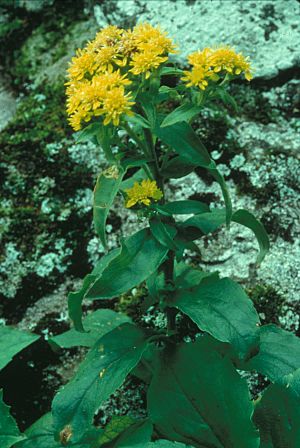Blue Ridge goldenrod facts for kids
Quick facts for kids Blue Ridge goldenrod |
|
|---|---|
 |
|
| Conservation status | |
| Scientific classification | |
| Genus: |
Solidago
|
| Species: |
spithamaea
|
| Synonyms | |
|
|
Solidago spithamaea is a special flowering plant. It is also known as the Blue Ridge goldenrod. This plant belongs to the aster family. It grows only in a small area. This area is near the border of North Carolina and Tennessee in the United States. Sadly, there are only three groups of these plants left. Their homes are being lost or damaged. Because of this, the Blue Ridge goldenrod is a federally protected species in the U.S. This means it is considered threatened.
Contents
Discovering the Blue Ridge Goldenrod
What Does This Plant Look Like?
The Blue Ridge goldenrod grows from an underground stem called a rhizome. It can reach a height of 10 to 40 centimeters (about 4 to 14 inches). The plant has a smell that some people find unpleasant. Its leaves change in shape and size. Leaves higher up the stem are smaller.
Its Unique Flowers
The plant's flowers grow in a bunch called an inflorescence. This bunch can be compact or spread out. It holds 15 to 50 or more flower heads. Each head has a bell-shaped base. This base is about half a centimeter (0.2 inches) long. It is lined with special leaves called phyllaries. These phyllaries have pointed, dark tips.
Inside each flower head, you will find 8 to 15 yellow ray florets. These are only a few millimeters long. They surround 20 to 60 disc florets. After flowering, the plant produces a fruit. This fruit is called an achene. It has a pappus of bristles, which helps it spread its seeds.
Where Does the Blue Ridge Goldenrod Live?
Solidago spithamaea grows on the high peaks of the Blue Ridge Mountains. You can find it in western North Carolina and eastern Tennessee. There is one group of plants in Avery County and one in Mitchell County in North Carolina. Another group is in Carter County, Tennessee. This whole area is only about 15 square miles (38 square kilometers).
Mountain Homes
You can spot this goldenrod on famous mountains like Grandfather Mountain, Hanging Rock, and Roan Mountain. It prefers rocky peaks, cliffs, and slopes covered in loose rocks called talus. Its home is often bare and open to the full sun. It also faces harsh winter weather.
A Plant from the Past
This goldenrod is a "relict species." This means it's a plant that was more common a long time ago. Back then, conditions were colder and wetter. As glaciers melted and moved away, the area became warmer and drier. Plants like this goldenrod were left behind. They survived in places that still felt like the cold, high-altitude climate they were used to. Now, they live on these high mountain peaks. These peaks have the toughest winter conditions. Not many relict goldenrods are found this far south.
Who Are Its Neighbors?
In this rocky habitat, the Blue Ridge goldenrod shares its home with other plants. These include mostly grasses and sedges. You can also find some other rare mountain plants and trees. These include:
- Heller's blazingstar (Liatris helleri)
- red spruce (Picea rubens)
- cliff avens (Geum radiatum)
- sandmyrtle (Kalmia buxifolia)
Protecting the Blue Ridge Goldenrod
What Dangers Does It Face?
The very places where this plant lives are popular for hiking and sightseeing. Sadly, much of its habitat has been changed. Roads, trails, parking lots, and other buildings have replaced its natural home. The remaining areas are easily damaged by people walking on them.
Other Threats
Other dangers to the Blue Ridge goldenrod include acid precipitation. This is rain that is more acidic than normal. Climate change is also a threat. These changes can make its habitat too warm or dry. This makes it harder for the plant to survive. Protecting these special mountain areas is important to help the Blue Ridge goldenrod thrive.


